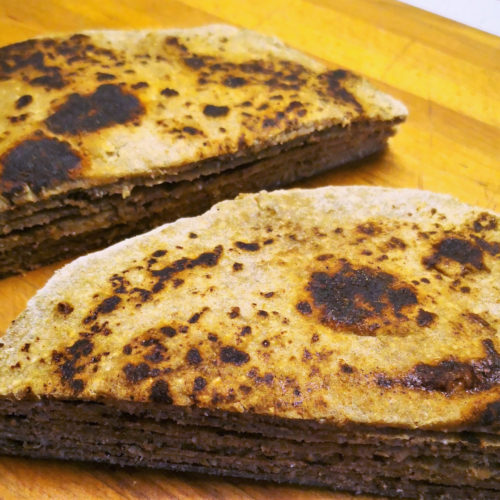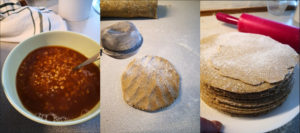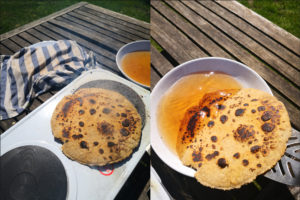
Traditional Icelandic Flatbread
When it came to a recipe I didn't have a family recipe that I grew up loving. Throughout Iceland there are a multitude of recipes that have been passed down from generation to generation. Everybody has the absolute best one of course. There are also the recipes that have been tweaked and adjusted to different dietary needs, and/or preference. You can find a recipe that suits every need. I have made mine, concocted from several different ones I found from various sources. I kept at it until I found a consistency and taste that I was happy with. Hope you will try it, and hope you love it as much as I do.
Equipment
- Large dough bowl
- Kettle
- Portable electric cooker
- Rolling Pin
- Bowl with cold water
- Some form of cooking utensils to turn the flatbread
- Kitchen towel - damp
- A plate or stencil that equals the size of your cooker/hob
Ingredients
- 2 cups plain flour
- 1/4 cup Manitoba flour
- 3/4 cup Ølands flour If you can get it, if not use either plain flour or Manitoba
- 1 1/4 cup rye finely ground
- 1/2 cup whole wheat flour I use corsely ground
- 1/2-1 tsp salt
- 1/2 tsp baking soda
- 1/2 tsp baking powder
- 1 1/2 tsp sugar
- 1/2 cup oats the same thing you use to make oatmeal
- 1+ tbsp malt syrup you can use whatever form of syrup or molasses ou want
- 2 cups boiling water
- 1 tbsp vegetable oil use a oil that is taste nutral
Instructions
- All dry ingredients, except oats, are measured and put into a bowl large enough to add water to and combine the dough in. Dry ingredients are mixed well together before any liquid is added.
- Boiling hot water is put into another bowl, adding malt syrup and oats, stirring until oats soften a little.
- The liquid is added to the dry ingredients, while it's still piping hot. Stir it together with a wooden spoon first and when it starts to come together, lightly knead it until the dough is uniform and just stays together. Don't over knead and if you need more water to combine the dry ingredients add a little more.
- Divide the dough into roughly 10-12 even pieces, forming them into balls. Leave for about 15 minutes so the dough softens a little. Dough normally needs a little time to "let go" after everything comes together. If you force it it can resist. I know this sounds funny but trust me. Because you want to flatten it out you want it to cooperate.

- Flatten each ball out like a tortilla until it is a flat round disc, about 2-3mm thick (about 0,08-0,12 of an inch - think tortilla). You can use your fingers, but I use a rolling pin. I try to make a perfect circle each time but I do use a plate the I know fits perfectly on my hob and cut off the excess. I put a lot of flour on both sides when I do this, as well as between them when I stack them so they won't stick together. It also eases the cooking process.
- Now comes the fun part. Set up your cooking station. You cook these outside or in an area that is extremely well ventilated like an open garage. You don't do it inside. Take your portable electric cooker and get situated on a table somewhere. Have your stack of flatbread on one side. On the other side you place a bowl of cold water and a damp kitchen towel folded over and on a plate. Now you are good to go.
- You turn the cooker on and wait until it is scolding hot. Then you place the first flatbread directly on it. At this stage your panic will set in. The burning smell and smoke goes against everything a cook knows as good practice, but trust me this is supposed to happen.

- You turn the flatbread after about 30 seconds and if it needs a bit more you just turn it again.
- When both sides are to your liking, or like the image shows you they should be, you do one more weird thing. Because you are quick burning these to cook them, you need to halt the cooking process just as fast. In order to do this you dip the whole thing in cold water. Go on don't be scared, really dip it in there, it can take it.
- After the ice bath the flatbread is kept inside the folded damp towel. Don't be afraid, the bread won't be soggy at all. They can handle this just fine.
- You will want to wrap the flatbread in something right away or else they will dry out. Get that sorted right away.
- The enjoy a warm flatbread with loads of butter and a few sprinkled saltflakes, or smoked lax or salmon. Just whatever you want. They are wonderful.